What would a person who does 100 push-ups every day look like after 20 days?
I asked that question because my app, PushUps Phone counter, https://apps.apple.com/cn/app/id1488091840#?platform=iphone, recently released a new version that includes a training plan feature. One of the training plans is “100 push-ups a day for 20 days.”
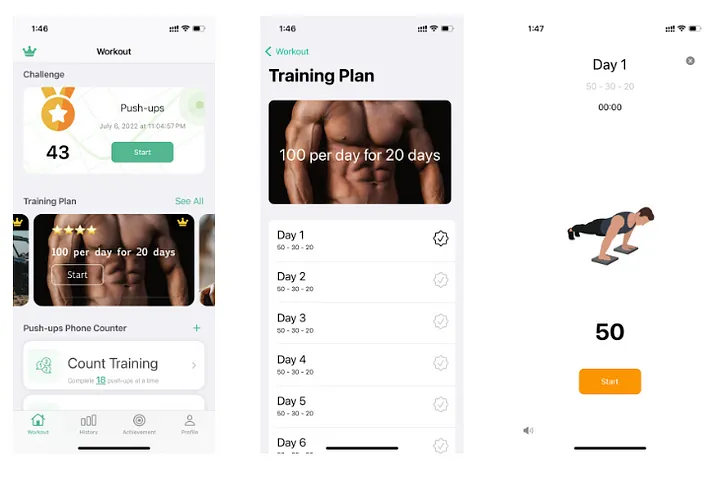
Regarding “PushUps Phone counter”, it is a small app I created during the pandemic in 2020. I also wrote an article about it before, titled “Staying at Home During the Pandemic: I Did 1000 Push-ups.” You can see that at the time, the app had a very basic design with a counting page as the homepage, followed by a history list and a simple settings page.
If you do 100 push-ups every day, you will notice significant improvements in your upper arms, chest, and core muscles after 20 days. However, the specific results also depend on your physical condition and dietary habits. This training plan can help you gradually improve your physical fitness and strength, but be sure to protect your body and avoid overtraining to prevent injury.
I have intermittently updated many versions of the app and added some commonly used features. The UI is also much cleaner and visually appealing compared to before. Later on, I will introduce more features.
Training Plan
Regarding the question at hand, doing 100 push-ups every day for 20 days, I am currently trying this training plan myself. However, I have not been able to consistently stick to it several times. This is because I know that if you are a beginner and not at that level, forcing yourself to do 100 push-ups every day for 20 days will most likely result in overtraining.
Fitness should be based on one’s own conditions and progressed gradually. If you feel that you can’t do it or feel uncomfortable, there’s no need to force yourself. Don’t engage in excessive exercise in a single session, and don’t push yourself to exhaustion.
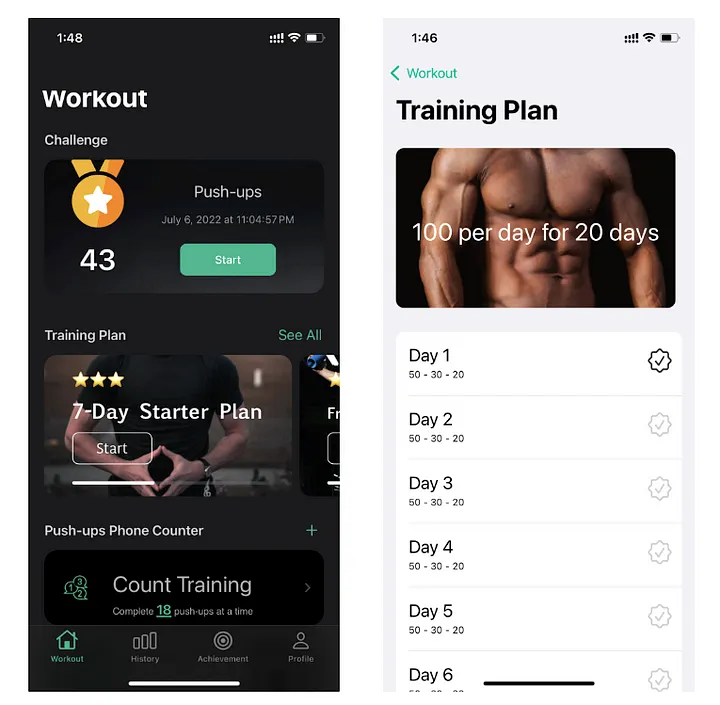
I had a colleague before who rarely exercised. Sometimes, on a whim and feeling guilty about eating too much recently, they joined us for a workout with a high intensity. As a result, they vomited several times after the workout and took one or two weeks to recover. It’s like what my previous running instructor told me: if you want to run far, don’t start too fast. When you haven’t been running for a while and want to start again, you should start with slow jogging for the first few times, covering a distance of about two to three kilometers.
Considering the points mentioned above, I have included beginner content and different plans for different situations in the training plan. However, even so, I don’t think it’s necessary to strictly follow the plan. It’s still important to consider one’s own situation. Therefore, in the training plan, I haven’t imposed any specific restrictions on consecutive days. In other words, you can continue with the previous plan every other day or complete two days’ worth of the plan in one day.
Challenge
Originally, I wanted to include a series of challenges, such as “longest duration of a single push-up,” “longest consecutive days,” “maximum number in a single day,” and so on. However, due to limited energy, I eventually decided to only include a “personal best” challenge. When you click on the challenge, you will enter the challenge page where you can compete against your own best records.
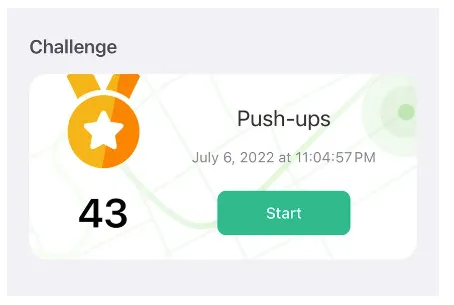
Phone Counter
The phone counter is the core feature of the initial version of this app. When doing push-ups, you place your phone on your chest or below your face. When your body comes close to or touches the circle in the middle of the screen, it records a push-up count. This works by utilizing the phone’s proximity sensor and light sensor. Near the front camera of the phone, it can detect when the body is close or moves away.
In the phone sensor mode, several target training methods are provided, such as counting repetitions, timing, and calculating calories. Intermittent training with grouping is also available, and users can click on the target number to adjust it themselves, giving them a high level of autonomy. Data history and statistics
calendar page
The calendar allows you to have a comprehensive overview of a specific month at a glance.
The calendar page is divided into month view and week view. The month view displays the push-up count for each day of a specific month, as well as the total count for the month, the total number of times, and the perfect attendance ratio. Please note that this is for statistical purposes only and not to encourage doing push-ups every day. 😁

The week view allows you to switch left and right to view the data for each day. You can see the total count for that day and the total number of sets done on that day. Clicking into each set will provide detailed analysis data. You can also manually add push-up records here with the button located in the upper right corner of the page.
History and Statistics
The history page displays push-up records in a regular list format, organized in chronological order. The screenshot on the left side above provides a clear overview.
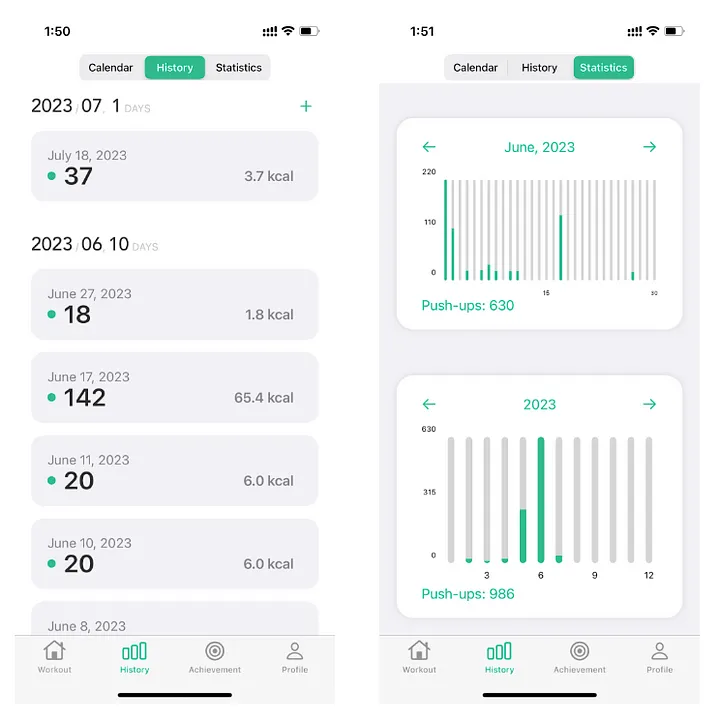
The statistics page mainly consists of charts that display data in bar charts for the past 7 days, the current month, and the current year. We are currently planning to add a time-switching feature, which will allow you to view data from previous weeks, months, and years. This feature should be available soon.
Achievements
Achievements Page
This is a function that was planned based on the purpose. Why do we do push-ups?
Is it for weight loss? Muscle building and toning? Maintaining cardiovascular health?
So, have you achieved your goals?
That’s why we planned to record three types of data: weight, body fat percentage, and resting heart rate. Weight corresponds to weight loss, body fat percentage corresponds to muscle building and toning, and resting heart rate corresponds to cardiovascular health.
In the upper right corner of the page, you can manually record data, and the line chart allows you to easily see the trends. Clicking into the details page allows you to view the data list and make changes to the data.
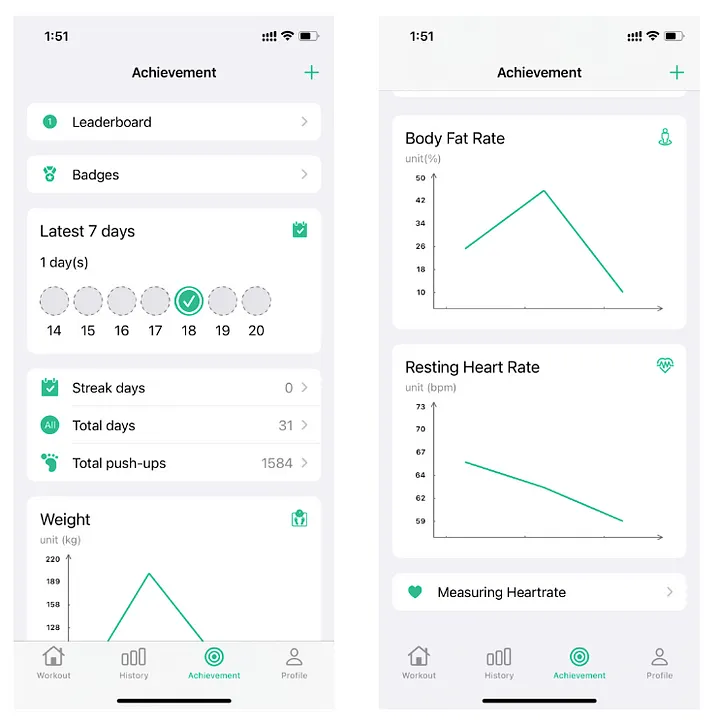
In fact, weight and body fat data are generally easy to obtain. If you have a body fat scale at home, you will have the data. Resting heart rate refers to the heart rate within the first two to three minutes after waking up. Resting heart rate tends to decrease in individuals who engage in regular exercise. Nowadays, most smart bands and watches have heart rate monitoring functions, so you can easily measure your resting heart rate when you wake up. If you don’t have any of these devices, you can actually use your phone’s camera to measure heart rate. You can use the app “Heart Monitor” Heart Monitor for this purpose.
Initially, I considered removing this page because a friend who works in product design said it feels out of place and that very few people are willing to manually record various data. They suggested replacing it with a feature to display earned and unearned medals. However, I have been using it myself and I think it is still useful, so I decided to keep it.
My Page and Settings Page
My Page and Settings Page
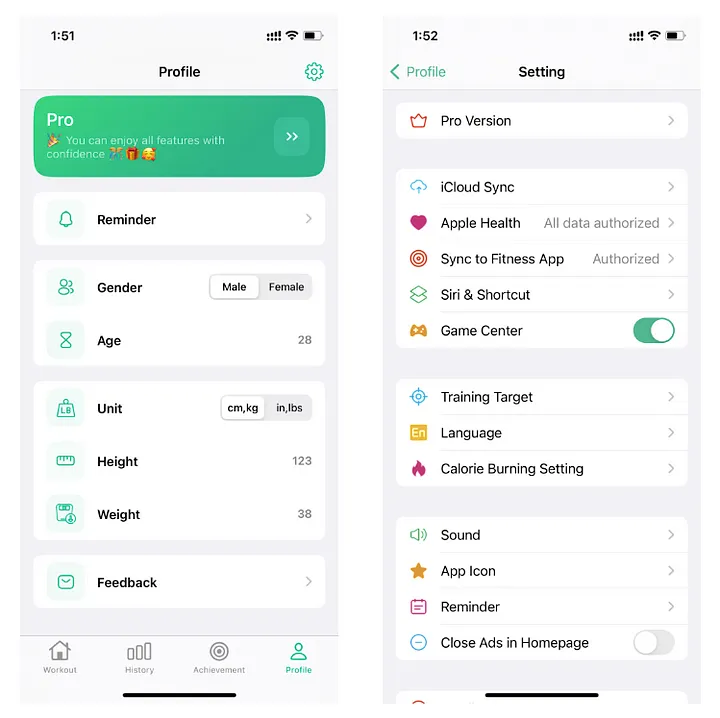
Both the My page and Settings page include some common features such as:
- Email feedback
- iCloud synchronization
- Apple Health integration
- Siri & Shortcuts
- Push-up reminders
- Theme color customization
- Goal settings
And so on. The list goes on, but these are some of the main features included in these pages.
Pricing
Finally, let’s talk about the pricing of the app. The monthly membership is priced at $5, and the annual membership is priced at $33. The main difference between the memberships is that they provide unlimited training plans, ad-free experience, and access to additional features in the future. Currently, all training plans are free. As some attentive users may have noticed, I have provided a button in the Settings page to disable ads, so the free version does not significantly impact the app’s usability.
Additionally, I am currently researching the possibility of implementing a cross-app shared subscription feature. This means that several apps can use the same membership subscription. I’m not sure if it can be done, but I am planning to develop a few similar apps like “Daily Squats,” “Daily Sit-ups,” and “Daily Plank” that can share the same membership subscription.
Comment for Promo Code
Thank you for reading until the end. I look forward to your suggestions and discussions. Thank you [bowing gesture].
